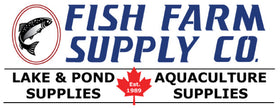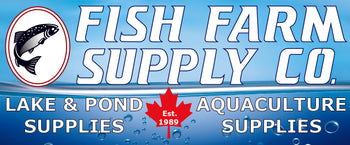Aquaculture & Aquaponic Information
- Home
- Aquaculture Info - Fi...
What is Aquaculture?
Aquaculture
Aquaculture can take on many forms, but it's simplest definition is growing fish for profit. This can be done in net pens within a lake or ocean, or in large tanks for a land-based operation. Fish can be raised from any stage of life (examples: from egg to fry, from egg to fingerling, fingerling to grow-out, breeders, etc.) and sold to another farmer, to a processor, to hobbyists, consumers, or many other markets.
Growing fish intensively for profit requires high capital expenditure, but has comparatively low operating expenses; mainly feed and labour. The main consideration of land-based aquaculture is location due to water demand. Massive water availability is key, as well as high water quality. In addition, pre-existing buildings or other infrastructure, and proximity to market (major cities with appropriate demand for live market, or processing facilities) are also major considerations.
Aquaponics
The combination of aquaculture with hydroponics (soil-less culture of plants and vegetables). Many different styles of plant beds are used, but all incorporate a lack of soil, and using water from fish tanks to nourish the plants. Fish produce both solid and liquid waste which is biologically degraded and then fertilizes the plants which grow rapidly as a result.
Marketing, business plan, and management should be focused on optimizing the vegetative/plant side of the system because that is the money maker, since it the major output from the system. The fish in an aquaponics system should be selected to based on market demand but should only be factored in as small component of the profit structure. Because of this most aquaponic facilities are set up with the majority of square footage occupied by plants and only a small area occupied by fish.
Legislation
Aquaculture is unlike most other forms of animal livestock production because of the use of common water resources and the production of both native and exotic species. Legislation is in place to conserve and manage water resources for all users and to protect habitat and natural fish populations. As a result, both the provincial and federal governments regulate aquaculture operations in Ontario. The Ontario Ministry of Natural Resources administers several licences under the Game and Fish Act.
- All fish farms require a Licence to Culture and Sell Fish which will stipulate which species may be raised at a particular location.
- A Licence to Stock Fish in Ontario Waters may also be necessary if fish are being stocked in ponds connected to open water.
- Fee fishing on private property requires a Fishing Preserve Licence, which enables the recipient to market recreational fishing opportunities without catch limits or season restrictions.
- The Ontario Ministry of the Environment and Energy administers the Ontario Water Resources Act (OWRA) which requires all water users in the province who use more than 50,000 litres of water a day to obtain a Permit to Take Water.
- The OWRA also regulates the discharge of wastewater from any industrial facility including fish farms. Any commercial fish farm that has an off-property discharge of water must obtain a Certificate of Approval. This often requires some form of waste treatment system for solids settling and removal.
In different circumstances, a variety of other approvals may be required by other provincial and federal government agencies such as the Department of Fisheries and Oceans, and Health Canada. Fish farmers must thoroughly investigate the regulatory requirements prior to purchasing land or commencing construction. Click here for more info.
See also: information on how to apply for a licence (aquaculture, fish collection, fish stocking, etc.), forms and the steps involved: Click here.
University of Guelph’s Aquaculture Centre
A great resource for anyone considering an investment in fish culture. Attend their workshop titled: “Getting Started in Aquaculture”. This workshop touches on many aspects of fish culture including the business, marketing, costs, water quality, legislation, and even hands-on tour of their working hatchery.
Approved Species for Culture in Ontario
|
Lake Sturgeon |
Pink Salmon |
Bluntnose Minnow |
|
Atlantic Salmon |
Rainbow Trout |
Fathead Minnow |
|
Brown Trout |
Lake Whitefish |
Redbelly Dace |
|
Brook Trout |
Lake Herring (Cisco) |
Finescale Dace |
|
Lake Trout |
Muskellunge |
Common Shiner |
|
Arctic Charr |
Northern Pike |
Golden Shiner |
|
Chinook Salmon |
Creek Chub |
Emerald Shiner |
|
Coho Salmon |
White Sucker |
Common Carp |
|
Goldfish |
Brown Bullhead |
Channel Catfish |
|
American Eel |
Largemouth Bass |
Smallmouth Bass |
|
Bluegill |
Pumpkinseed |
Black Crappie |
|
Walleye |
Sauger |
Yellow Perch |
|
Tilapia |
Crayfish |
|
Some Key Planning Questions to consider to get you started:
- What species of fish do you want to raise?
- What is your rearing plan? What stage(s) of life do you want to raise them for?
- Who will you sell them to? How will you market them?
- What kind of system will you use? Recirculating, flow-through, etc.
- What quantity of fish will you raise? What size of facility will you need?
- What are your water requirements?
- What are your feed requirements?
- What will your start-up cost be? Yearly operating costs?
Other relevant links for general information and resources:
Aquaculture Center at the University of Guelph
Ontario Aquaculture Research Center - Introduction to Aquaculture and Aquaponics
Ontario Aquaculture Association
Aquaculture Legislation in Ontario

